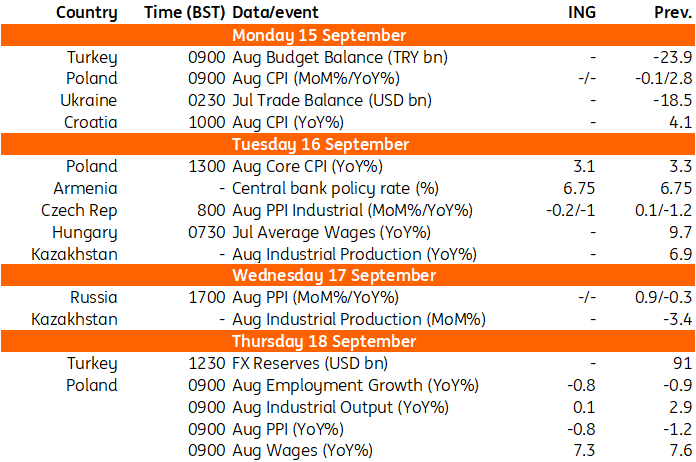Tesla shares recover following third-quarter profit miss
In next week’s round of central bank meetings, we’re looking for 25bp cuts from both the Federal Reserve and the Bank of Canada. Meanwhile, the Bank of England should hit pause, though any hints of further easing will be closely monitored
THINK Ahead in Developed Markets
United States
Rate decision (Wed): The focus will be on the Federal Reserve meeting on Wednesday. While inflation remains elevated, the jobs numbers are looking worse and worse. There has been limited jobs growth seen over the past four months, and recent data revisions suggest more than half of the jobs that had reportedly been added in the 12 months to March were found not to actually exist! A cooling economy and weakening jobs market will help to dampen inflation tied to tariffs, and the Fed is now in a position to resume loosening policy from “somewhat restrictive” territory towards a neutral footing. We look for a 25bp rate cut with rates heading towards 3.25% by March from the current 4.5% ceiling level.
Retail sales (Tue): In terms of data, retail sales will be held back by subdued consumer sentiment and a fall in auto sales. Industrial production may contract yet again based on manufacturing survey evidence.
United Kingdom:
Jobs report (Tue): The jobs market is a wild card for the Bank of England, and we’ll be watching for any further weakness in the payroll figures. Recent surveys have been improving, which tentatively suggests the worst is behind us for the jobs market, but it’s a key risk going into the autumn. We’ll also be looking for confirmation that wage growth is coming down.
Inflation (Wed): The BoE is particularly sensitive to food inflation right now, and this is set to notch above 5%. Services inflation should inch lower, though. If we’re right, then this report shouldn’t materially move the dial on the Bank of England’s rate-cutting path. We still expect a November rate cut, though a big upside surprise on inflation would be a catalyst for us to change our mind on that.
Bank of England (Thu): A rate cut was never likely at this meeting, given the BoE’s preference for cutting rates once per quarter, and having done so in August. We doubt the Bank will fundamentally change its forward guidance either, which, despite hinting at further cuts, suggests rates are getting closer to neutral.
Canada
Rate decision (Wed): The Bank of Canada is widely expected to cut interest rates by 25bp. Canada’s economy is heavily exposed to US President Donald Trump’s US tariffs, and the output contracted sharply in the second quarter while employment fell for a second consecutive month in August, pushing the unemployment rate up to 7.1%. Inflation is broadly in line with the target, so the BoC has room to move rates closer to the bottom end of the perceived “neutral range”. We think it will cut once more in the fourth quarter.
THINK Ahead in Central and Eastern Europe
Poland
CPI (Thu): The final August CPI should be close to the flash estimate of 2.8% year-on-year. Detailed data should allow for a more precise calculation of core inflation, which, according to our estimates, moderated to 3.0-3.1% YoY from 3.3% YoY reported in July. Declining headline and core inflation were the main rationale for a series of rate cuts by the National Bank of Poland (NBP), which has reduced its reference rate by 100bp so far. Policymakers are more cautious here as rates are lower, and we may need to wait until the November sitting for another 25bp rate cut.
Industrial output (Thu): Since the German economy remains idle, Polish industrial production has been generally stagnant in recent quarters. August is a traditional month of production breaks in the automotive industry, and the calendar was unfavourable (with fewer working days than in August 2024), so any strong positive number in annual terms would be a positive sign. PPI also remained in deflationary territory last month. The Polish economy continues to expand on the back of the services sector.
Labour market report (Thu): Wage growth continues easing, albeit gradually, as the labour market remains tight despite some cooldown in demand for workers. Still, structural tensions (deteriorating demographic and decline in labour supply) dominate over cyclical factors. Employment continues its downward trend. The domestic gauge of unemployment increased somewhat, but the broader Labour Force Survey (LFS) detailed a nearly 100,000-person decline in the number of unemployed in the second quarter of 2025. The LFS unemployment rate in Poland remains among the lowest in the European Union.
Czech Republic
PPI (Tue): Industrial producer prices have likely remained in an annual decline in August, reflecting weakening Brent crude prices and a strengthening koruna against both the dollar and the single currency in July and August. The reduced cost for all imports is set to weigh on producer prices despite the onset of a gradual recovery in Czech manufacturing.
Armenia
Rate decision (Tue): We expect the Central Bank of Armenia (CBA) to keep the refinancing rate unchanged at 6.75% at the upcoming board meeting on 16 September. The cutting cycle has been on hold since February due to global uncertainties and fiscal easing, which pose risks to the CPI trend despite the strong dram and a slowdown in economic activity. Inflation picked up to 3.6% YoY in August, exceeding our expectations and making a cut less likely.
Key Events in Developed Markets Next Week

Source: Refinitiv, ING
Key Events in EMEA Next Week

Source: Refinitiv, ING
Disclaimer: This publication has been prepared by ING solely for information purposes irrespective of a particular user’s means, financial situation or investment objectives. The information does not constitute investment recommendation, and nor is it investment, legal or tax advice or an offer or solicitation to purchase or sell any financial instrument. Read more
